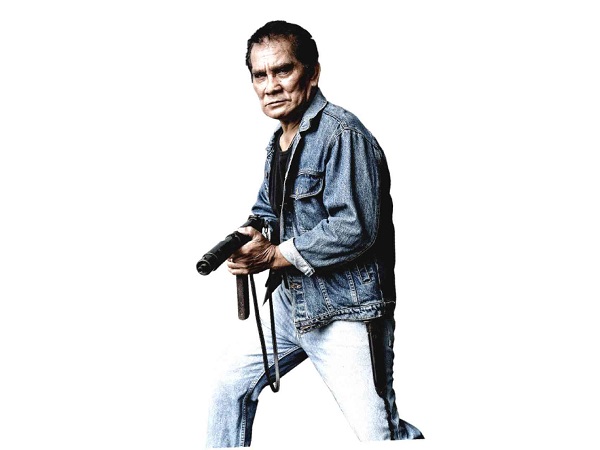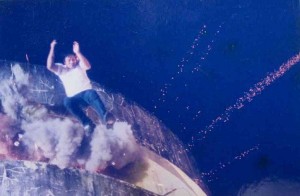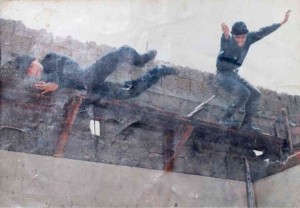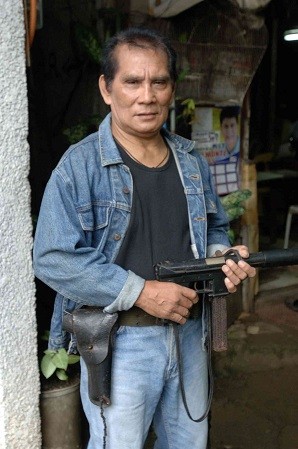
One day in December, 2004, stuntman and now fight director Andy Lora, 70, recalled rushing to St. Luke’s hospital in Quezon City after he heard that “Manager” had suffered a heart attack during a party.But when he reached the hospital, Lora saw people weeping, Vandolph Quizon among them. The atmosphere had turned gloomy.

“You’re late. ‘Manager’ is dead,” a stuntman friend told him.
Lora’s world stopped, his heart felt like it snapped in two and his mind could not comprehend what he had just heard. Comprehension dawned finally, painfully: The King of Action films was gone.
For Lora, Fernando Poe Jr. (FPJ) was more than a star. He was a close friend, an icon, an inspiration, the man who personally knew the plight of stuntmen, having also started as one in 1955 for Everlasting Pictures. For more than two decades, “Manager” was Lora’s usual fighting partner in Filipino movies. But now, he had left them.
The following night, Lora tasked 50 to 100 stuntmen and women under his group Alas Stuntmen to serve as marshals during Manager’s wake and burial, free of charge.
“When ‘Manager’ was alive, our livelihood came from him. Now that he’s dead, should we continue earning from him?” Lora told the volunteer marshals who had asked for an allowance.

Lora, a member of the defunct but well-known stuntman group SOS Daredevils, said he earned a good living in the movies, thanks to FPJ whom he doubled for and did fight scenes with, in several FPJ productions.
Lora was a farmer in Leyte, before his wife managed to convince him to go to Manila in the 1950s and seek his fortune in the city. He had expected to land an office job, and was frustrated to find nothing but construction work at P4 a day. He had reached only grade six in school.
Months after, he learned about the SOS Daredevils from a neighbor who was looking for stuntmen.
“I used to watch movies back in the province and dreamt of being an extra, even in horror films,” Lora said. He grabbed the opportunity and attended training thrice a week with the SOS. He was 20 years old at the time.

As a stuntman, Lora fought with the biggest names in show business—Ramon Revilla Sr. and Jr., Manny Pacquiao, Lito Lapid, Bernard Bonnin, Jess Lapid Sr. among them. Some big stars have also started practising their stunts with the SOS Daredevils including Mario Montenegro, Johnny Montero, Mario Escudero, Eddie Garcia, Lito Lapid and Dante Varona.
FPJ, also a stuntman and an SOS Daredevils original, immediately became his role model and idol. Lora found out that FPJ used to crawl on a rope to move from one building to another as a stuntman.
At the SOS headquarters was a three-storey tower where stuntmen were trained to fall down. “As a beginner, you were held by two people before you jump a building and a safety net caught you at the bottom,” he said.

As the stuntmen trained further, they were no longer given support nor safety net because falling down on cue had become easier, he added.
Looking tough also mattered, said Lora who said he used to buy costumes, mostly Americana (formal coat), and used shoes with heels. Standing only 5’5”, the stuntman said he had to look taller because most of the lead stars he was working with were 5’8” to 5’10” in height.
To look even more credible, stuntmen had regular training sessions to master such stunts as holding a gun, and had to go to the gym regularly to get in perfect shape.
Lora proudly recalled that FPJ often chose him to do stunts in his movies “because I’ve mastered them.” He added: “‘Batang FPJ,’ that’s how people on the set used to call me.”

At the SOS Daredevils’ school for stuntmen, one learned how to ride a horse, drive a fast car, crash through a glass window, fall off a cliff, jump from tall buildings, get bumped by a racing car, fight credibly with toughies, get hit by a bullet and, finally, die in a cinematic but believable way.
Such skills used inordinately in movie roles had meant risks to life and limb, and Lora himself had his share of such episodes. His most memorable experience as stuntman was that time when he almost drowned.
In “Kumander Surot,” he doubled for Chiquito, while two other stuntmen Ronald Arsenan and Rey “Manok” doubled for Liz Alindogan. The scene? The three of them had to jump off Jones Bridge in Manila, with a boat on stand-by—a contingency he had requested from the producer.

Unfortunately, Rey did not know how to swim and dragged the other man down as well. Lora, who wore heavy shoes and a jacket, tried to save them, but also nearly drowned when he panicked. The rescue boat proved handy and the three were rescued. Lesson learned? There should always be a back-up or contingency should anything go wrong, and never lie, especially about your capabilities, Lora cited.
Needless to say, being a stuntman is dangerous business. Like law officers, one goes to work in the morning with one foot in the grave, so to speak. Knowing such risks are part of the job, Lora still trains arduously and regularly with members of the Alas Stunt group at the Parks and Wildlife Center in Quezon City.
“We prepare for our stunts well, but you really wouldn’t know when accidents happen,” he said.

At a shoot in Laoag, Ilocos Norte for “Mariposang Dagat” starring Vivian Velez and Mat Ranillo III, Lora almost got blinded after the edge of gun hit him in the eye. In another instance, he fell off a galloping horse and suffered a permanent fracture to his hand, which he showed to this reporter.
“Ganito ang buhay namin. Bago ka magkaroon ng pangalan, kailangan mo munang dumaan sa butas ng karayom (This is our life. Before you can earn a name, you have to go through the eye of the needle),” he said.
Lora recalled several instances when stuntmen had died in accidents on the set. One Alex Flores died around 1995 when the plane they were on during a shoot crashed. There were other stuntmen who perished after falling out a helicopter, he added.

In the film “Bawal na Gamot,” a stuntman inside a minibus that was meant to burn down, committed a costly mistake and paid dearly with his life. He should have jumped to the left side to avoid getting burned along with the bus. Instead, he had plowed straight ahead, and died.
Another stuntman wielding a machine gun was told to jump from the tower he was standing on before a truck bumped it. But he wasn’t fast enough.
In “Isusumbong Kita sa Tatay Ko” starring Fernando Poe Jr. and Judy Ann Santos, a woman who doubled for Juday had to jump from a ten-storey building together with another double. The woman fainted after hitting the other double at the ground floor where a net awaited them. The woman was paid P15,000 for the stunt, and got an additional P10,000 from FPJ, Lora said.
But the woman got bitten by a dog and had to shell out P4,500 for anti-rabies injections, as the job offered no medical insurance.
Accidents do happen on the set, Lora said, and surviving stuntmen know most likely what and how things went wrong.
Still, being a stuntman has its rewards, he added. Fighting with the most popular lead stars for one, has earned him the right to be called a character actor.
Lora also became a lead star when his life story was featured in a movie and a commercial. “You’re not just a stuntman, you’re a character actor,” he said.
But times are changing, and not just because local movies and small-time actors have lost a patron in FPJ, resulting in fewer action films. The boom in digital movies has meant less work for stuntmen as well, Lora groused.
“Live stunts can already be done through animation and special effects. Many stuntmen now do not have a job, he added.
He used to get paid P4,500 per day, higher than most stuntmen since he was considered an “FPJ kid.”
“Lagari ako noon. I was usually booked for three films a day,” he recalled.
These days, P1,000 a day is heaven-sent. Getting projects has become harder, as some people consider him too old or too expensive to hire.
He has had to level up. In the indie film “Daniel Rapido” directed by Dyzal Damon and Carlo Montero, Lora played a goon but also acted as fight director training other stuntmen.
Thinking of the future though is something that the movie industry has not made any easier. Lora said the insurance provided by the Movie Workers Welfare Foundation (Mowelfund) and their allowance are their only buffers against lean times in the future, though a few stuntmen have managed to save for a business or a small store. “Knowing the nature of our work, insurance companies don’t want to accept our application,” he said.
As a Mowelfund member since 1974, he pays P30 in subscribers’ fee, while some new members pay a P500 membership fee.
No wonder Lora’s four children register no interest to follow in his footsteps. Well, except for his 11-year-old granddaughter, who now practices with him at the Parks and Wildlife Center in Quezon City.
It takes a lot more than practice to become a good stuntman though. He’s not in prime condition, Lora admitted, pointing to his paunch.
Control too is a good discipline to have. A good fighting partner, Lora said, knows how to control his moves. The punches should be fake and controlled lest they result in injuries to the other person. “I always go home with bruises, cuts and a black eye; that’s part of the job,” he said.
For Lora, respect is the key to staying in the job: respect for yourself, your craft and the other people around you. Do not use what you know for personal gains; don’t fight for the sake of fighting, he said.
While Lora found his dream through the SOS Daredevils, Rigo Ramirez, 47, found a direction in his life when he became a stuntman and part of the group Manlulundag.
“I am a street dweller, then. I have a family but I used to be a street child before,” he recalled.
From Antipolo, he would go to faraway places including Malate, to watch the SOS Daredevils practice their stunts. He was surprised to find out that his older brother Rudy (they were 12 siblings) was himself working as stuntman.
From working at construction just across the SOS gym, Ramirez was finally convinced to try his luck at doing stunts. At 11 years, he started practising as a stuntman.
Ramirez admitted to an early fascination with movie stars on the set. It was part of this sense of fulfilment as a stuntman, a double and now a fighting director.
As for Lora, seeing stars often meant learning something new. He can’t forget what his idol, action star Lito Lapid, told him once about coming from really humble beginnings. Lapid said: “Magsikap ka. Mag-aral ka sapagkat ang kaalaman mo, sa iyo lang iyan; ni minsan di maagaw ng iba (Work hard, study. Your learning is yours alone and can’t be stolen).”
For his part, Ramirez found redemption in his craft. “I could have become a big-time snatcher, or hired killer if I had not been recruited in this group,” he said. “Wala namang ibang pupuntahan ang mga batang kalsada, di ba (What else could a streetchild become)?” he said, adding that being a stunt actor has made him a more responsible and disciplined person.
Ramirez usually plays the role of a goon in action films including “Eseng ng Tondo” and “Butas ng Karayom” which starred FPJ. With Lito Lapid, he did stunts in “Madelo.”
It’s a job that’s lucrative as well, he said, although not as good as a regular job that allows him the little extras in life. Stunt actors can net as much as P24,000 monthly (P3,000 a day, twice a week), or P50,000 as a fight director, and suddenly become jobless the next four months.
He cited life’s uncertainties as another factor. Once, he was tasked to jump from the eighth floor of the building but the job was postponed because it was windy. No money that day. The next day, the weather was better, and he jumped. He was paid P45,000.
Death is not a new or macabre topic for stuntmen. “I’m prepared for death, but as much as possible, we study the stunts so we can execute them well and avoid injuries,” Ramirez said.
The most important thing he has learned so far is patience. Before a trainee gets to play a role in a movie, he has to wait one and a half year and must train consistently.
“A patient man is better than the hardworking stuntman,” he said. “You have to wait for your turn,” he added. He believes that one should be ripe for the picking first and equipped with the necessary skills before getting the big break.
Things have changed these days though and Ramirez said he is frustrated by the fact that “pretty faces who lack training can now beat a learned and skillful stuntman.” The camera wants beautiful people and that’s how stuntmen are marginalized, plus of course, the fact, that digital films have led to less stunt projects. Digital animation has proven a less risky and cheaper option.
Since being promoted as fighting director, Ramirez said he has been sharing his blessings with other stuntmen. “If you get it all, hindi na kasipagan iyon; kaswapangan na iyan (it’s no longer hard work but greed if you try to take all the jobs).”
During the interview, Ramirez brought along stuntmen Al Panuncio, 26, and Danilo Lising, 40, who have all become part of TV 5’s “Undercover,” and all geared up waiting for their next project.
Lising readily said that stuntmen are looked down upon by people who regard them as takaw away, basagulero and harmful, people you don’t mess with.
He doesn’t want his children to experience the things he’s experienced, Lising says. “I don’t want my child to feel the things I feel… I want him to be an accountant.”
Ramirez, on the other hand, wants his child to be a doctor. “I don’t want him to be a stuntman,” he said.
For this actor and other members of the Manlulundag club (literally, Jumpers club), stunt work is a leap of faith, given the pay, the risks involved and the competition with digital images on the computer.













































